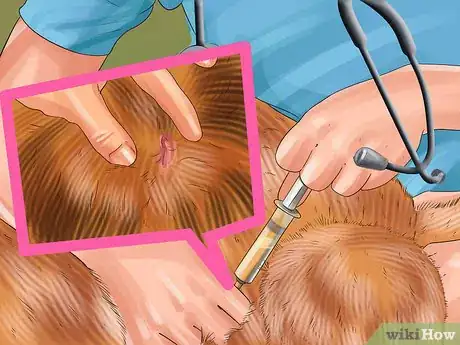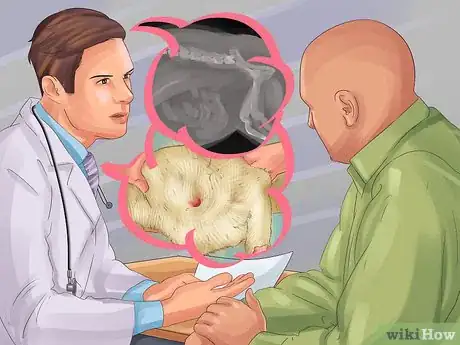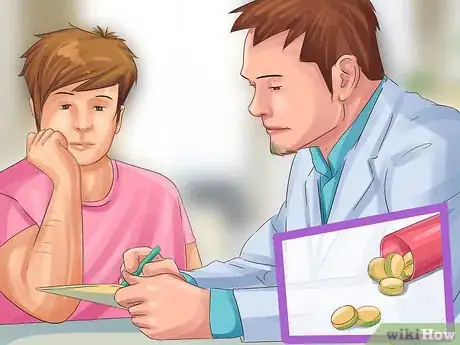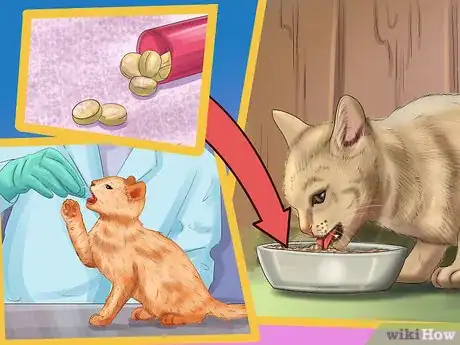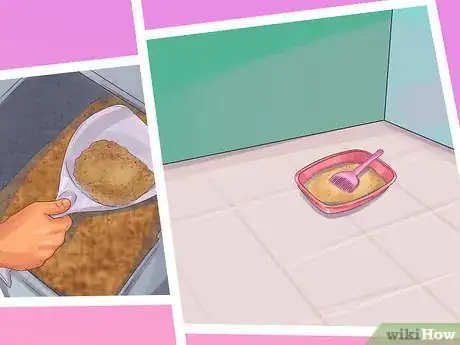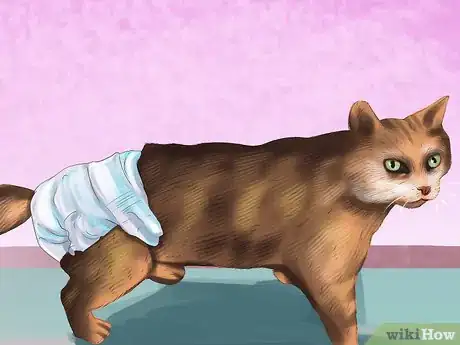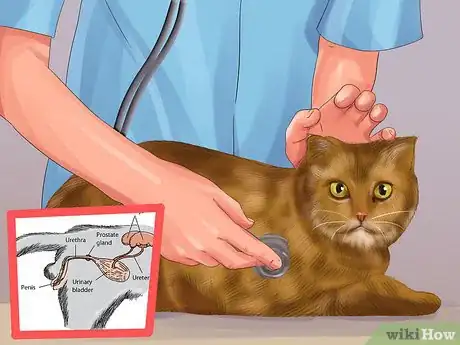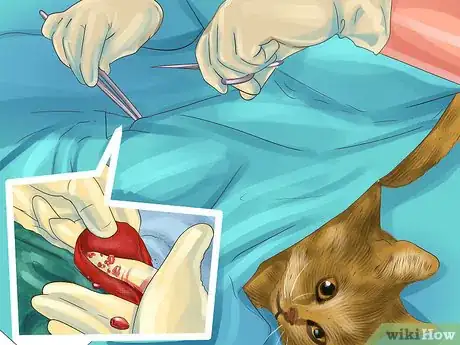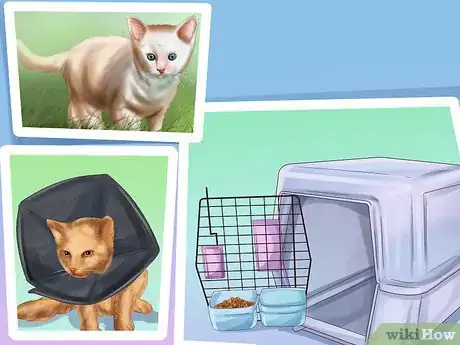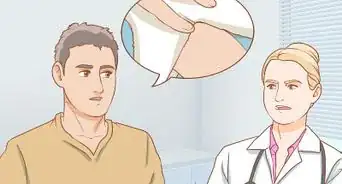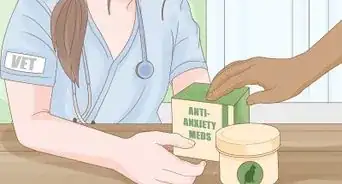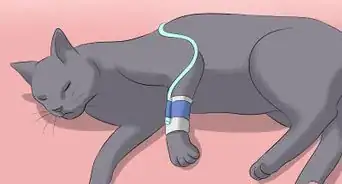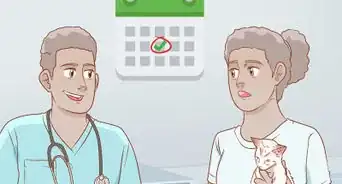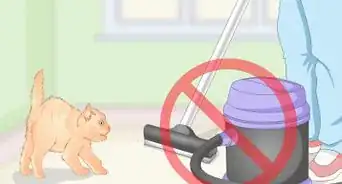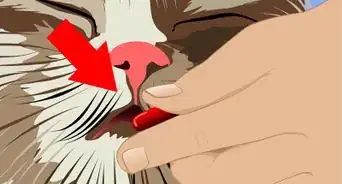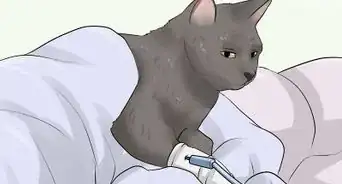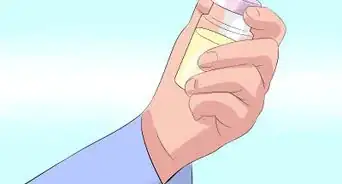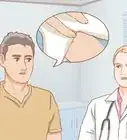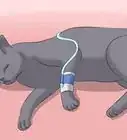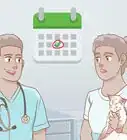This article was co-authored by Pippa Elliott, MRCVS. Dr. Elliott, BVMS, MRCVS is a veterinarian with over 30 years of experience in veterinary surgery and companion animal practice. She graduated from the University of Glasgow in 1987 with a degree in veterinary medicine and surgery. She has worked at the same animal clinic in her hometown for over 20 years.
This article has been viewed 21,437 times.
It can be frustrating when your litter box-trained cat can no longer control their bladder. This condition, known as urinary incontinence, is often caused by obesity, medical issues like diabetes or bladder stones, or old age. Your cat can also develop urinary incontinence if they are prone to bladder issues or infections.[1] If your cat displays any symptoms of urinary incontinence, you should see your vet right away. You can then take care of your cat at home or try surgical intervention to help treat this issue.
Steps
Getting a Diagnosis From Your Vet
-
1Allow your vet to do a physical exam and run tests. If your cat displays the symptoms of urinary incontinence, including an inability to urinate, bloody or cloudy urine, a loss of bladder control, or straining or crying out in pain when urinating, you should take them to the vet right away. Getting your vet to diagnose the issue will ensure your cat gets the right treatment. Your vet will do a physical exam of your cat, including looking at their abdominal area. They may also run several tests to determine the cause of your cat’s bladder problems.[2]
- Your vet may run a urinalysis, where they will test your cat’s urine for bacteria as well as red or white blood cells.
- Your vet may also do an x-ray of your cat’s abdominal area to check for bladder stones. They may inject your cat with a special dye so the bladder is easier to see in the x-rays.
-
2Discuss your cat’s diagnosis. There are several possible causes of urinary incontinence in cats and your vet will be able to tell you which one your cat is dealing with. You should discuss your cat’s diagnosis with the vet so you understand why they are having issues with their bladder. The possible causes of urinary incontinence include:[3]
- Feline diabetes: Your cat may have developed diabetes, which can cause them to drink large amounts of water. They may then try to use the litter box but fail to make it in time.
- A urinary tract infection (UTI): Your cat may have a UTI, which will cause them to try to urinate but to no avail. If you think your cat as a UTI, get them to your vet right away.
- Bladder stones: Some cats are prone to bladder stones, which can cause straining when they try to urinate, constant urination, blood in their urine, and a tender abdominal area.
- Old age: Older cats may become senile and forget to urinate in their litter boxes. Senior cats also have weakened muscles, making it more difficult from them to control their bladder.
- Obesity: Some cats who are overweight will have difficulty controlling their bladder. You may notice your cat appears overweight, especially if you cannot see their ribs.
Advertisement -
3Find out your cat’s treatment options. Your vet will outline your cat’s treatment options, based on their diagnosis. Your cat may require medication and diligent home care to ensure they recover. Your vet may also suggest surgical intervention if your cat’s situation is dire.[4]
- If your cat has diabetes, your vet will prescribe medication and dietary changes.
- If your cat has a UTI, your vet will prescribe antibiotics that your cat must take until the UTI goes away.
- If your cat has bladder stones, your vet may suggest surgery to remove the bladder stones. You may also need to adjust your cat’s diet.
Doing Home Care
-
1Give your cat the necessary medication. You should make sure your cat gets the medication prescribed to them by the vet, such as antibiotics for a urinary tract infection. Follow your vet’s instructions on dosage and make sure your cat consumes the medication.[5]
- If your vet prescribes medication in pill or capsule form, place the medication in the center of a small ball of canned cat food or a piece of cheese. Try to get your cat to swallow the small ball with the medication whole, as they may not want to eat it if they bite into the medication and it leaves a bad taste in their mouth.
- You can also try to place the medication in your cat’s mouth directly, though you should use caution as you do not want to get bit by your cat. To do this, hold your cat’s head from the top with your non-dominant hand, placing your fingers around your cat’s cheekbones. Then, tilt their head back so their jaw falls open.
- Use your dominant hand to put the medication far back on your cat’s tongue. Then, shut their mouth and stroke their head or blow in their face to encourage them to swallow the medication.
-
2Adjust your cat’s diet. Your vet may recommend that you adjust your cat’s diet if they are diagnosed with diabetes or obesity. You should follow your vet’s recommendations and adjust your cat’s diet so they are not at risk of other worsening health issues. A change in diet can also help your cat gain better control of their bladder.[6]
- You should make sure you cat has access to fresh water on a regular basis, as this will allow your cat to drink the water and flush out their bladder.
-
3Keep your cat’s litter box clean. You should also keep your cat’s litter box clean and dry to encourage them to go to bathroom. You may try to clean the litter box more than usual so your cat feels more comfortable urinating in their litter box.[7]
- If your cat is old and senile, you may place several litter boxes around your home so your cat also more opportunities to go to the bathroom in the litter box. You may also lead your cat to their litter box if they appear to have forgotten where it is located.[8]
- You may also keep your cat's litter box in a room that has hardwood, tile, or linoleum floors so that if they have an accident on the way to the litter box, it is easier to clean up.
-
4Put your cat in diapers. If your cat does not seem to be able to go to the bathroom in their litter box, your vet may recommend the use of diapers. You may need to put your cat in diapers temporarily until they recover. This will prevent accidents on your furniture or your carpet.[9]
-
5Schedule a follow up appointment with your vet. You should schedule a follow up appointment with your vet so your cat can be examined again and tested for bladder issues. Your vet may do another urinalysis to determine if the treatment is working.[10]
- If your cat appears unresponsive to treatment, your vet may run additional tests to try to identify other causes of the urinary incontinence.
Trying Surgical Intervention
-
1Have your cat get surgery to remove obstructions in their bladder. If your cat is diagnosed with obstructions in their bladder, such as bladder stones, your vet may recommend surgery to remove them. The surgery can be invasive and expensive, but it will effectively relieve your cat’s pain and discomfort.[11]
- The surgery to remove bladder stones is called a cystotomy. It is performed by making an incision through your cat’s belly and removing the stones from your cat’s bladder.
- Keep in mind cats who develop bladder stones have a high risk of getting them again. Your vet may recommend medication or changes to your cat’s diet to prevent the bladder stones from coming back.
-
2Allow your doctor to repair your cat’s urinary tract. If your cat’s urinary incontinence is due to damage to their urinary tract, your vet may suggest surgery to repair your cat’s urinary tract. Though the surgery may be costly, it may be necessary if your cat’s urinary tract is damaged.[12]
-
3Help your cat recover after surgery. Your cat may need some tender loving care after their surgery to ensure they recover well. You should limit your cat’s activity so they can heal. Keep your cat indoors, such as in a crate or a small room in your home.[13]
- You may also avoid giving your cat a bath so the incision area does not get wet. Try to examine the incision area often to ensure it is healing properly.
- You may need to get a pet cone so your cat does not try to lick or pick at the incision area.
References
- ↑ https://www.petcarerx.com/article/8-reasons-for-cat-incontinence-and-out-of-litter-box-messes/1423
- ↑ http://www.petplace.com/article/cats/diseases-conditions-of-cats/symptoms/urinary-incontinence
- ↑ https://www.petcarerx.com/article/8-reasons-for-cat-incontinence-and-out-of-litter-box-messes/1423
- ↑ https://www.petcarerx.com/article/8-reasons-for-cat-incontinence-and-out-of-litter-box-messes/1423
- ↑ https://www.vetmed.wsu.edu/outreach/Pet-Health-Topics/categories/procedures/cats/giving-oral-medications-to-your-cat
- ↑ http://www.petplace.com/article/cats/diseases-conditions-of-cats/symptoms/urinary-incontinence
- ↑ http://www.petplace.com/article/cats/diseases-conditions-of-cats/symptoms/urinary-incontinence
- ↑ https://www.petcarerx.com/article/8-reasons-for-cat-incontinence-and-out-of-litter-box-messes/1423
- ↑ https://www.vetinfo.com/treatment-feline-incontinence.html
- ↑ http://www.petplace.com/article/cats/diseases-conditions-of-cats/symptoms/urinary-incontinence
- ↑ https://www.petcarerx.com/article/8-reasons-for-cat-incontinence-and-out-of-litter-box-messes/1423
- ↑ http://www.petmd.com/cat/conditions/urinary/c_ct_incontinence_urinary?page=2
- ↑ https://www.petcarerx.com/article/caring-for-your-cat-after-surgery/831
About This Article
Before you treat your cat for urinary incontinence, make sure to visit your vet to get a diagnosis, since incontinence can be caused by many different things and requires different types of treatment. If your vet prescribes medication, such as antibiotics, try hiding the pill in a piece of cheese to encourage your cat to eat it. Alternatively, you may simply need to get your cat to drink more water to flush out bacteria from its bladder. While your cat is recovering, you can try fitting it with pet diapers to prevent it from having an accident on your furniture or carpet. To learn how to determine if your cat needs surgery for its incontinence, read more from our Veterinary co-author.
